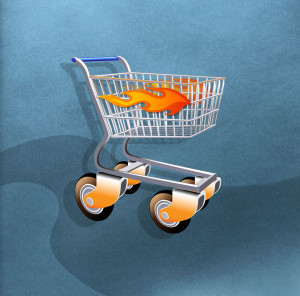January 29th, 2014 by Elma Jane
Ecommerce and mobile-based e-commerce have grown significantly this year. Cyber Monday ecommerce sales, as an example, reached $1.735 billion originating from desktop and laptop devices, according to comScore. Even Black Friday, which is better known for brick-and-mortar retail sales, saw online spending reach $1.198 billion in the United States, again according to comScore. Mobile online spending may also have grown, as some reports indicate that mobile-based site traffic was up 55 percent around Thanksgiving.
Many ecommerce merchants are enjoying a robust holiday selling season even as some brick-and-mortar stores are seeing relatively flat Christmas sales. To ensure continued growth and success, Internet retailers may want to challenge their businesses to improve in several areas in 2014.
Retailers, however, should not rest on their current success, but rather should challenge their businesses to improve in several areas, including free shipping offers, mobile optimization, personalization, data driven decision making, and cross channel sales.
Offer Free, Two-Day Shipping
The first challenge for online sellers in 2014 may be to find ways to offer free, two-day shipping to all or most shoppers. While it is likely there will still be minimum purchase and maximum weight requirements and restrictions, online shoppers are going to expect faster free shipping options thanks, in part, to the growth in services like Amazon Prime and ShopRunner.
Consider order fulfillment services, distributed warehouses, drop shipping, or even partnerships with other retailers to help meet this challenge.
Offer Personalization and Customization
Personalization and customization could be a significant competitive advantage in 2014.
Challenge your business to finally begin offering personalization and customization both onsite and in marketing. The easiest place to start may be with email marketing. Work to segment email marketing campaigns so that they address customers by name and with relevant products and offers that are based on an individual’s or group of shoppers’ stated preferences or on-site behavior.
Taking on this challenge means that the retailer’s marketing department will need to collect meaningful information about what interests shoppers and organize separate, custom campaigns around those interests.
Put Mobile Design and Marketing First
In November, IBM reported that mobile devices accounted for 31 percent of U.S. ecommerce-related web traffic around the Thanksgiving holiday this year, and that 17 percent of ecommerce transactions came from smartphones or tablets. On average, tablet users spent more than $126.00 per order, and smartphone users spent about $106 per order.
This data shows that mobile e commerce is not simply a novelty, but rather a must have for 2014.
If an e-commerce business is not optimized for mobile sales, 2014 is the year to take on that challenge, including offering a responsive design and mobile friendly payment options.
Sell Seamlessly Across Channels, Devices
Try to think of every way that a shopper might interact with an online store, and then make all of those touch points work together in 2014.
Retailers online or in physical stores need to offer shoppers a seamless, cross channel shopping experience that makes buying things easier for the customer. To continue to enjoy success in 2014, consider offering shoppers the ability to share orders across devices, applications, and even marketplaces.
In practice, this might mean that items added to a cart in an online store show up in the cart for the retailer’s iPhone app too. Or that a customer’s order history displayed on a retailer’s site shows orders placed on-site and via a marketplace like Amazon or eBay.
Use Big Data for Big Information
In 2014, find sources of good, usable Big Data, and put the resulting big information to use.
As an example consider, Weather Trends International, a Big Data company that uses historical weather information and advanced data processing to accurately predict weather 11 months in advance. This sort of Big Data information could show a snowboard and ski retailer what sort of winter major ski resorts are likely to have next year, and could inform purchasing and inventory choices.
Similarly, knowing that a particular region is going to have a warmer than normal July and August might impact how, where, and when a clothing retailer promotes shorts or bikinis on Facebook or AdWords.
Big Data is a popular trend in business and in marketing. The concept can mean different things to different businesses. For ecommerce, retailers should seek to use Big Data to gather big information, if you will, that may be used to make better buying and selling decisions.
Posted in Credit card Processing, e-commerce & m-commerce, Electronic Payments, Internet Payment Gateway, Mobile Payments, Mobile Point of Sale, Smartphone, Visa MasterCard American Express Tagged with: adwords, Amazon, big data, big information, brick and mortar, cross channel, cyber, drop shipping, e-commerce, ecommerce, Facebook, internet retailers, laptop devices, Mobile Devices, mobile friendly payment options, mobile optimization, mobile-based site, on-site, online, online shoppers, online store, onsite, personalization, retailers marketing, retailers online, shopping experience, smartphone, Smartphones, tablet, tablets
September 26th, 2013 by Elma Jane
5 Effective and Unusual Ecommerce Pricing Strategies
Most online retailers set pricing using the cost-plus or the value-based method. While these work well, there are several other ways to price products. Here are the five effective and unusual ways to price products on your ecommerce site.
1. Name your Price
This is a variation of the PWYW model, where the price has to exceed a threshold to get the product. This threshold price is not shown to shoppers to allow them to name their own price. This model has been successfully used in the travel industry, among others, where availability of airlines, hotels, and travel dates is based on the named price. This strategy can also work well for online retailers that are selling the following types of products.
Defined Price Ranges – Gifts site where NYP can be a guide to show products that are within that price range. NYP can be used as a guided selling tool to show gifts within a defined price range. The retailers can use price discrimination in combination with this strategy to increase their profits.
High Perceived Value – The perceived value of the product is much higher than the cost of procuring it, prompting the consumers to name a higher price. This can apply to books, music, and food products.
Imprecise Value – The products can be sold at a wide range of prices and still generate a profit. This could include one-of-a-kind products or art, where it is difficult to assess the value.
2. Pay What You Want
The pay-what-you-want strategy — PWYW — has been around for a while but has not been used heavily in the online retail space. A well-publicized offline success is Panera Bread restaurants, which has used this pricing strategy in a few of its restaurants. In the online world, Humble Bundle a music and game store has been using this too. In almost all cases, this strategy did not result in a significant profit or loss but led to a lot of free marketing. That is one of the big reasons for adopting this strategy in retail. There are several types of online retailers that can benefit.
Limited Categories – This strategy does not need to be implemented for your complete online store. It can be limited to a few products or a few categories that are the best fit.
Link to Charities – If your site shares revenue with charities, then PWYW can work, as customers often pay more to help the charity, increasing your share of the revenue in the process.
Offer an Incentive – You can also tie the PWYW strategy with an incentive…such as an additional product once the price exceeds a certain threshold, say $10. This threshold can be kept secret or made public on the site as a marketing tactic to encourage customers to pay more.
Proper Customers – If you believe that your customers are fair-minded and understand the value of your products, then PWYW might be effective.
3. Personalized Pricing
This is a relatively new strategy where specialized yield management algorithms are used to personalize the price offered to each visitor. With the rise of Big Data, most of the personalized pricing is done in real-time by analyzing a variety of factors like customer loyalty, device used by the shopper, customer preferences, history of purchases, and so on. This strategy is best suited for the following types of online retailers.
New Products Regularly – There are many products in the online store, with new products introduced regularly. This makes personalized pricing more effective as repeat customers see the new product and the new promotional pricing to reward their loyalty, or to encourage a first purchase for new ones.
Repeat Customers – Customers know that they will be rewarded with personalized pricing and promotions based on the loyalty to your site.
Wide Profit Margins – Products are sold with good margins, allowing the retailer to offer discounts at any time. For example if the product is sitting in a shopper’s cart for a few days, the retailer might offer a discount or drop the price to encourage the shopper to complete the purchase.
4. Flat Pricing
Flat pricing is a strategy where a limited number of prices are used for all product offerings, such as in dollar stores where every product is priced at one dollar. This strategy works well in the following situations.
Many Similar Products – Your site sells a wide variety of products that are priced nearly the same. In this scenario, flat pricing is simpler to manage, easier for consumers, and also results in greater profit.
Subscription Pricing – A new trend in online retail is subscription pricing, where customers can sign up for a flat price of, say, $25, $49, or $99 to receive a set of products every month.
5. Free
Several software companies are using free pricing successfully where the software is given away for free and customer is charged either for support or for premium features. A free pricing strategy can be an effective strategy for ecommerce merchants to attract customers by following the following guidelines.
Basic vs. Premium Versions – This strategy can be effective if the basic version is free and the customer pays for a premium version. The life insurance industry uses this approach, where a basic $10,000 insurance is often free. If even a small percentage of customers buy the premium offering, the insurer makes a profit.
Emphasize Consumables – Products that have durable and consumable components can benefit from a free pricing strategy, if customers can only buy both pieces from your site. For example, Gillette sometimes offers shaving razors for free since only Gillette shaving blades will work with its razors. On the other hand, it does not make sense to give away a laser printer for free because the printer paper and toner can be bought from anywhere.
Loss Leader – Use this strategy to offer products for free using the loss leader model. Customers come to the site to get the free products and once they are on the site, you can up-sell or cross-sell them other products.
Seasonal Products – If your site sells seasonal products, then this strategy can drive traffic. For example, a retailer could give away free U.S. flags during the July 4th holiday to generate traffic, while also pushing other non-free July 4th merchandise.
Posted in e-commerce & m-commerce, Electronic Payments, Travel Agency Agents Tagged with: Airlines, e-commerce, hotel, online store, pricing, subscription, travel industry

